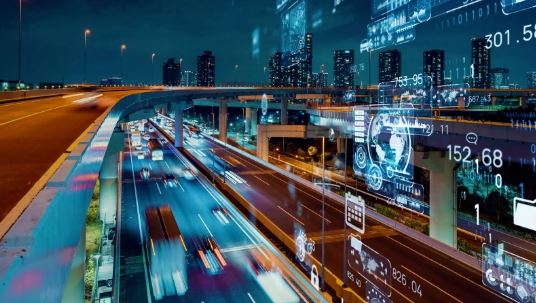Download PDF
Digital Transformation of Rail Rapid Transit System with Claroty

Technology Category
- Application Infrastructure & Middleware - Middleware, SDKs & Libraries
- Platform as a Service (PaaS) - Application Development Platforms
Applicable Industries
- Railway & Metro
- Transportation
Applicable Functions
- Maintenance
- Quality Assurance
Use Cases
- Cybersecurity
- Tamper Detection
Services
- Cybersecurity Services
- System Integration
The Challenge
The mass rapid transit system, with over 20 lines spanning nearly 1,500 kilometers, transports billions of passengers annually across urban and suburban districts. The system relies on specialized industrial networks for railway electrification, signaling, communications, and an extensive building management system (BMS) for station and tunnel ventilation, lighting, and physical security. The rail operator faced challenges in maintaining visibility and control across these networks while adhering to stringent international safety integrity level (SIL) standards. The digitization and connectivity demands of passengers and vendors, who require timely updates and access to OT, IoT, and IIoT assets, posed a significant challenge. The legacy OT systems, designed with isolation in mind, were not equipped to connect and communicate with IT systems and the internet. The rail operator had no visibility into their industrial networks, making response and remediation of system failures difficult. Compliance with SIL standards was mandatory, and any third-party equipment introduced into the network had to work independently from safety-critical systems or integrate without affecting these systems and triggering recertification. The multiple layers of legacy OT systems, designed for a lifespan of 25 to 50 years, added further complexity to modernization efforts.
The Customer
Not disclosed
About The Customer
The customer is a mass rapid transit system operator with more than 20 lines that span nearly 1,500 kilometers, transporting billions of passengers a year across urban and suburban districts. The system relies on a series of specialized industrial networks for railway electrification, signaling, and communications, and an extensive building management system to support station and tunnel ventilation, lighting, and physical security. The operator is responsible for maintaining operational efficiency and security across these networks while complying with rigorous international safety integrity level (SIL) standards. The operator also faces the challenge of modernizing legacy OT systems that were designed for a lifespan of 25 to 50 years.
The Solution
To secure their expansive, heterogeneous OT environment and safely connect with IT systems, the rail operator partnered with Claroty. They utilized components of The Claroty Platform, including Continuous Threat Detection (CTD) for full spectrum OT, IT, and IoT visibility, continuous security monitoring, and real-time risk insights. The Secure Remote Access (SRA) was used to safeguard industrial networks from threats introduced via unmanaged and unmonitored access by remote users. The Enterprise Management Console (EMC) simplified management at scale, consolidating data from Claroty products and providing a unified view of assets, activities, and alerts across multiple networks, tracks, and stations. The Claroty Platform also integrated seamlessly via the EMC with IT security infrastructure. Claroty's solution allowed the rail operator to digitize without compromising security, providing connectivity for remote parties, and enabling equipment manufacturers to seamlessly access systems remotely to service equipment.
Operational Impact
Related Case Studies.

Case Study
Airport SCADA Systems Improve Service Levels
Modern airports are one of the busiest environments on Earth and rely on process automation equipment to ensure service operators achieve their KPIs. Increasingly airport SCADA systems are being used to control all aspects of the operation and associated facilities. This is because unplanned system downtime can cost dearly, both in terms of reduced revenues and the associated loss of customer satisfaction due to inevitable travel inconvenience and disruption.

Case Study
IoT-based Fleet Intelligence Innovation
Speed to market is precious for DRVR, a rapidly growing start-up company. With a business model dependent on reliable mobile data, managers were spending their lives trying to negotiate data roaming deals with mobile network operators in different countries. And, even then, service quality was a constant concern.

Case Study
Digitize Railway with Deutsche Bahn
To reduce maintenance costs and delay-causing failures for Deutsche Bahn. They need manual measurements by a position measurement system based on custom-made MEMS sensor clusters, which allow autonomous and continuous monitoring with wireless data transmission and long battery. They were looking for data pre-processing solution in the sensor and machine learning algorithms in the cloud so as to detect critical wear.

Case Study
Cold Chain Transportation and Refrigerated Fleet Management System
1) Create a digital connected transportation solution to retrofit cold chain trailers with real-time tracking and controls. 2) Prevent multi-million dollar losses due to theft or spoilage. 3) Deliver a digital chain-of-custody solution for door to door load monitoring and security. 4) Provide a trusted multi-fleet solution in a single application with granular data and access controls.

Case Study
Vehicle Fleet Analytics
Organizations frequently implement a maintenance strategy for their fleets of vehicles using a combination of time and usage based maintenance schedules. While effective as a whole, time and usage based schedules do not take into account driving patterns, environmental factors, and sensors currently deployed within the vehicle measuring crank voltage, ignition voltage, and acceleration, all of which have a significant influence on the overall health of the vehicle.In a typical fleet, a large percentage of road calls are related to electrical failure, with battery failure being a common cause. Battery failures result in unmet service agreement levels and costly re-adjustment of scheduled to provide replacement vehicles. To reduce the impact of unplanned maintenance, the transportation logistics company was interested in a trial of C3 Vehicle Fleet Analytics.

Case Study
3M Gains Real-Time Insight with Cloud Solution
The company has a long track record of innovative technology solutions. For example, 3M helps its customers optimize parking operations by automating fee collection and other processes. To improve support for this rapidly expanding segment, 3M needed to automate its own data collection and reporting. The company had recently purchased the assets of parking, tolling, and automatic license plate reader businesses, and required better insight into these acquisitions. Chad Reed, Global Business Manager for 3M Parking Systems, says, “With thousands of installations across the world, we couldn’t keep track of our software and hardware deployments, which made it difficult to understand our market penetration.” 3M wanted a tracking application that sales staff could use to get real-time information about the type and location of 3M products in parking lots and garages. So that it could be used on-site with potential customers, the solution would have to provide access to data anytime, anywhere, and from an array of mobile devices. Jason Fox, Mobile Application Architect at 3M, upped the ante by volunteering to deliver the new app in one weekend. For Fox and his team, these requirements meant turning to the cloud instead of an on-premises datacenter. “My first thought was to go directly to the cloud because we needed to provide access not only to our salespeople, but to resellers who didn’t have access to our internal network,” says Fox. “The cloud just seemed like a logical choice.”





